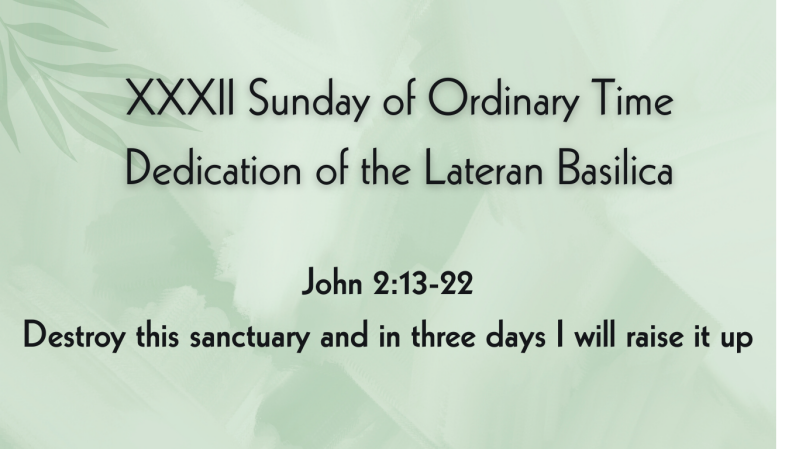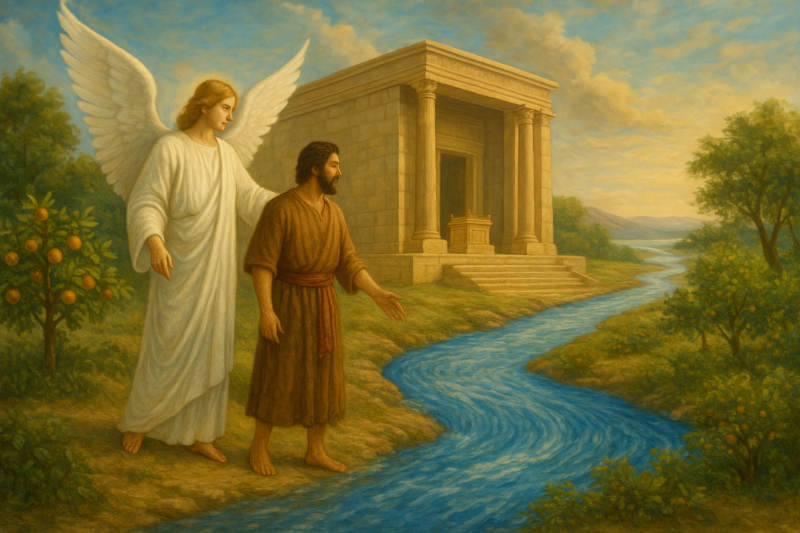

Just before the Jewish Passover Jesus went up to Jerusalem, and in the Temple he found people selling cattle and sheep and pigeons, and the money changers sitting at their counters there. Making a whip out of some cord, he drove them all out of the Temple, cattle and sheep as well, scattered the money changers’ coins, knocked their tables over and said to the pigeon-sellers, ‘Take all this out of here and stop turning my Father’s house into a market.’ Then his disciples remembered the words of scripture: Zeal for your house will devour me. The Jews intervened and said, ‘What sign can you show us to justify what you have done?’ Jesus answered, ‘Destroy this sanctuary, and in three days I will raise it up.’ The Jews replied, ‘It has taken forty-six years to build this sanctuary: are you going to raise it up in three days?’ But he was speaking of the sanctuary that was his body, and when Jesus rose from the dead, his disciples remembered that he had said this, and they believed the scripture and the words he had said.
This Sunday, we celebrate the Foundation Solemnity of the Lateran Basilica. Located in the center of Rome, this church is the Cathedral of the Pope and the place where the Holy Father traditionally used to teach Christian doctrine. The word “cathedral” comes from the Latin word for “chair,” signifying the seat from which the Pope instructs the faithful. Today, the Holy Father typically teaches from St. Peter’s Basilica, in the heart of the Vatican.
The liturgy of the Word, though varied, reveals a central truth: the temple is the dwelling place and house of God. In the First Reading from Ezekiel, the temple is described as a source of healing and fulfillment. In the Old Testament, it was a sacred area where the Almighty God received the glory and thanksgiving of His people, and at times, He healed those who came to pray.
In the Second Reading, from St. Paul’s letter to the Corinthians, we see another perspective. The Apostle to the nations points to Jesus Christ as the foundation of the New Temple, which is the Body of Christ and represents the modern meaning of the Church. Jesus Christ is both the Head and the Body of the Church.
The Gospel of John brings these themes together, presenting the temple as the House of God. Jesus’ actions—driving out the animals and the money changers—are a sign of sanctity and the presence of God. At the same time, Jesus foretells the creation of a new temple: His Body, the Holy Church, made up of those who believe in Him.
Today, as baptized people, we are the spiritual bricks in the Glorified Body of Christ. Through His death and resurrection, Christ makes us His spiritual temple.
We thank God for His goodness, and for the physical buildings—the churches—where we believe the Lord is present, ready to heal and to comfort. Every day, we can come before the Lord to offer our prayers, intentions, and thanksgiving.
Every element of the church—the altar, statues, paintings, and mosaics—reminds us that the Almighty God is among us. Amen.

Zbliżała się pora Paschy żydowskiej i Jezus udał się do Jerozolimy. W świątyni napotkał tych, którzy sprzedawali woły, baranki i gołębie, oraz siedzących za stołami bankierów. Wówczas sporządziwszy sobie bicz ze sznurków, powypędzał wszystkich ze świątyni, także baranki i woły, porozrzucał monety bankierów, a stoły powywracał. Do tych zaś, którzy sprzedawali gołębie, rzekł: „Weźcie to stąd, a nie róbcie z domu mego Ojca targowiska”. Uczniowie Jego przypomnieli sobie, że napisano: „Gorliwość o dom Twój pożera Mnie”. W odpowiedzi zaś na to Żydzi rzekli do Niego: „Jakim znakiem wykażesz się wobec nas, skoro takie rzeczy czynisz?”. Jezus dał im taką odpowiedź: „Zburzcie tę świątynię, a Ja w trzech dniach wzniosę ją na nowo”. Powiedzieli do Niego Żydzi: „Czterdzieści sześć lat budowano tę świątynię, a Ty ją wzniesiesz w przeciągu trzech dni?”. On zaś mówił o świątyni swego ciała. Gdy zatem zmartwychwstał, przypomnieli sobie uczniowie Jego, że to powiedział, i uwierzyli Pismu i słowu, które wyrzekł Jezus.
W tą niedzielę obchodzimy uroczystość poświęcenia Bazyliki Laterańskiej. Znajdująca się w centrum Rzymu, ta świątynia jest katedrą papieża i miejscem, gdzie Ojciec Święty tradycyjnie nauczał doktryny chrześcijańskiej. Słowo „katedra” pochodzi od łacińskiego słowa oznaczającego „krzesło”, wskazując miejsce, z którego papież naucza wiernych. Obecnie Ojciec Święty najczęściej naucza z Bazyliki św. Piotra, z serca Watykanu.
Liturgia Słowa, choć różnorodna, ukazuje jedną podstawową prawdę: świątynia jest mieszkaniem i domem Boga. W pierwszym czytaniu z Księgi Ezechiela świątynia opisana jest jako źródło uzdrowienia i obfitości. W Starym Testamencie była to przestrzeń święta, gdzie Wszechmogący Bóg odbierał chwałę i dziękczynienie swego ludu, a czasami uzdrawiał tych, którzy przychodzili się modlić.
W drugim czytaniu, z Listu św. Pawła do Koryntian, otrzymujemy inną perspektywę. Apostoł narodów wskazuje na Jezusa Chrystusa jako fundament Nowej Świątyni, którą jest Ciało Chrystusa i która stanowi współczesne rozumienie Kościoła. Jezus Chrystus jest zarówno Głową, jak i Ciałem Kościoła.
Ewangelia według św. Jana łączy te tematy, przedstawiając świątynię jako Dom Boga. Działania Jezusa – wypędzenie zwierząt i przekupniów – są znakiem świętości i obecności Boga. Jednocześnie Jezus zapowiada powstanie nowej świątyni: Jego Ciała, Świętego Kościoła, tworzonego przez tych, którzy w Niego wierzą.
Dziś jako ochrzczeni, jesteśmy duchowymi cegłami w Uwielbionym Ciele Chrystusa. Przez Swoją Śmierć i Zmartwychwstanie Chrystus czyni nas swoją duchową świątynią.
Dziękujemy Bogu za Jego dobroć oraz za materialne budynki – kościoły – w których wierzymy, że Pan jest obecny, gotów uzdrawiać i pocieszać. Każdego dnia możemy stawać przed Panem, by składać nasze modlitwy, intencje i dziękczynienie.
Każdy element kościoła – ołtarz, figury, obrazy i mozaiki – przypomina nam, że Wszechmogący Bóg jest pośród nas. Amen.
Add comment
Comments